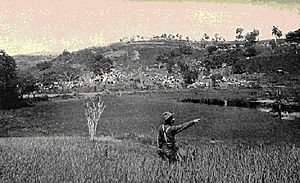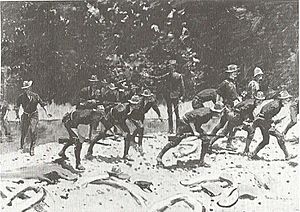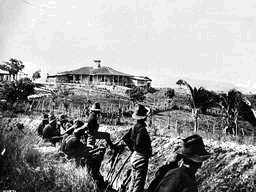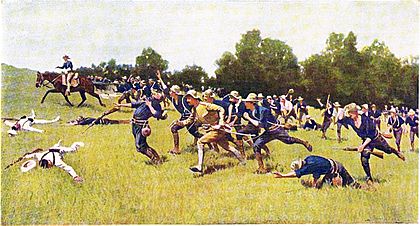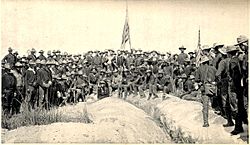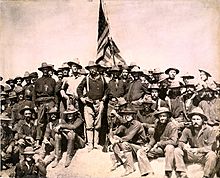Battle of San Juan Hill facts for kids
Quick facts for kids Battle of San Juan Hill |
|||||||
|---|---|---|---|---|---|---|---|
| Part of the Spanish–American War | |||||||
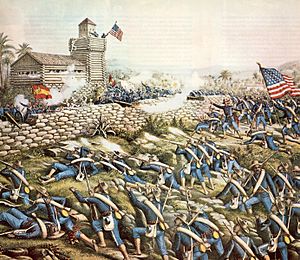 Charge of the 24th and 25th Colored Infantry, |
|||||||
|
|||||||
| Belligerents | |||||||
| Commanders and leaders | |||||||
| William Shafter Joseph Wheeler Theodore Roosevelt |
Arsenio Linares y Pombo | ||||||
| Strength | |||||||
| 8,412 4 gatling guns |
521 | ||||||
| Casualties and losses | |||||||
| 144 killed 1,024 wounded 72 missing |
114 killed 366 wounded 41 captured |
||||||
The Battle of San Juan Hill, also known as the Battle for the San Juan Heights, was a very important fight during the Spanish–American War. It happened on July 1, 1898, near Santiago de Cuba in Cuba. American forces, led by generals William Rufus Shafter and Joseph Wheeler, fought against Spanish soldiers led by General Arsenio Linares y Pombo.
This battle was one of the most famous and difficult parts of the war. It helped decide the outcome of the American army's fight in Cuba. The American forces had many more soldiers than the Spanish defenders. They charged up the hills and, after losing many soldiers, pushed the Spanish away.
Before the war, there were many problems between Spain and the United States. Americans were upset by stories of Spanish cruelty against the people of Cuba. In January 1898, the American ship USS Maine was sent to Cuba to protect American interests. Less than a month later, the ship exploded in Havana harbor, killing 261 sailors. Many Americans blamed Spain, even without clear proof. Two months later, the United States declared war on Spain.
After landing troops in Cuba, the Americans moved inland to find the Spanish army. Both sides fought at the Battle of Las Guasimas. The Spanish then moved to defend the important San Juan Heights. A week later, a much larger American force, including the famous 'Rough Riders', moved to attack these heights. The Americans faced heavy gunfire, but they charged up the hills and won. This fight became the bloodiest and most well-known battle of the war.
The battle was also a "greatest victory" for the Rough Riders. Their new commander, Theodore Roosevelt, became very famous. He later became vice president and then president of the United States. In 2001, he was given the Medal of Honor for his bravery in Cuba. He is the only U.S. president to receive this award. The Americans also won a battle at El Caney on the same day. These battles showed the courage of both American and Spanish soldiers. After the Spanish army surrendered in Santiago, they left Cuba. This ended over 400 years of Spanish rule there.
Contents
Why the Battle Happened
Spanish General Arsenio Linares had 760 soldiers defending the San Juan heights. For some reason, he did not send more of his nearly 10,000 reserve soldiers from Santiago de Cuba to help.
The Spanish had dug trenches and built forts on the hills. However, some of their defenses were not in the best spots. This made it harder for them to shoot at the American soldiers as they got closer to the bottom of the hills. But once the Americans started climbing, they were in full view. The Spanish could then shoot at them with rifles and cannons.
Most Spanish soldiers were new recruits, but their officers were experienced. The Spanish had good artillery and modern Mauser M1893 rifles. These rifles were fast and used powerful smokeless powder. Their cannons were also modern and fired quickly.
The American soldiers used Krag rifles, which also used smokeless powder. However, American cannons were older and fired slowly. They used black powder, which limited how far they could shoot. The Americans also had a special unit with four Gatling Guns. These guns were hand-cranked but could fire very fast, over 700 shots per minute. They could also turn to shoot across a wide area.
General William Rufus Shafter was in charge of about 15,000 American troops. His plan was for one division, led by General Henry Ware Lawton, to attack the Spanish fort at El Caney first. This was supposed to take only two hours. Then, Lawton's division would join the main attack on San Juan Heights. The other two divisions would attack San Juan Heights directly. General Shafter was too sick to lead from the front. He set up his headquarters about 2 miles (3 km) from the hills. He sent messages using officers on horseback.
Who Fought in the Battle
The American forces were part of the Fifth Army Corps. Major General William Rufus Shafter was the main commander. Major General Joseph Wheeler led the Cavalry Division, which fought on foot.
Important units included:
- The 1st Division, led by Brigadier General Jacob Ford Kent. This included the 6th, 16th, 71st (New York Volunteer), 2nd, 10th, 21st, 9th, 13th, and 24th (Colored) U.S. Infantry Regiments.
- The Cavalry Division, led by Major General Joseph Wheeler. This included the 3rd U.S. Cavalry, 6th U.S. Cavalry, 9th U.S. Cavalry, 1st U.S. Cavalry, 10th U.S. Cavalry, and the 1st Volunteer Cavalry.
The American attack line stretched across the hills. On the far left, attacking San Juan Hill, were the 6th, 9th, 13th, 16th, and 24th (Colored) Infantry. The 10th (Colored) Cavalry attacked both high points. On the far right, attacking Kettle Hill, were the 3rd Cavalry and the 1st Volunteer Cavalry (Rough Riders).
The Battle Begins
American soldiers waited at the base of the hills. They were under constant fire from Spanish Mauser rifles. This area was called "Hell's Pocket" or "Bloody Ford" because of how dangerous it was. A hot air balloon from the Signal Corps went up to scout the hills. But it became an easy target for the Spanish.
The American generals waited for Lawton's division to arrive from El Caney. But Lawton's troops were delayed. No new orders came from General Shafter or Wheeler. The soldiers were getting hit by Spanish bullets while they waited.
Taking San Juan Hill
General Hamilton Hawkins' brigade prepared to attack San Juan Hill. This was the taller of the two hills. The Spanish had a strong blockhouse, a defensive fort, at the top. American soldiers were in the open, taking fire as they waited for orders. As more and more shots came in, officers wanted to attack.
Two regiments, the 2nd and 10th Infantry, were ordered to move forward. They advanced and pushed back Spanish soldiers. A young officer, First Lieutenant Jules Garesche Ord, asked General Hawkins if he could lead a charge. Hawkins told him, "I will not ask for volunteers, I will not give permission and I will not refuse it. God bless you and good luck!"
Lt. Ord then asked other units to support the regular soldiers. He returned to his unit, the 10th Cavalry, and ordered them to advance. The "Buffalo Soldiers" (members of the 10th Cavalry Regiment) moved out of their trenches and up the hill. Other units, like the 24th all-black Infantry Regiment and parts of the 6th, 9th, and 13th Infantry Regiments, also charged. The 71st (New York Volunteer) infantry regiment stayed behind. As they climbed, the units became mixed together.
The American army used machine guns for the first time in an attack. Lt. John Parker's Gatling gun unit had four guns. They were set up about 600 yards (550 m) from the Spanish blockhouse. The Gatlings fired a constant stream of bullets into the Spanish lines. This intense fire made many Spanish defenders run away. The Gatlings kept firing until a signal told them to stop to avoid hitting American soldiers. The American attack then turned into a full charge about 150 yards (140 m) from the top.
Major William Auman was the first officer to reach the top of San Juan Hill. Lt. Ord was also among the first. As the Spanish ran, Lt. Ord directed fire at the remaining Spanish. He was then badly wounded. General Hawkins was also wounded soon after. At 1:50 PM, Private Arthur Agnew pulled down the Spanish flag from the blockhouse.
Taking Kettle Hill
At the same time, the 1st U.S. Volunteer Cavalry (the Rough Riders) and the 3rd Cavalry Regiment attacked Kettle Hill. They were supported by the 10th Cavalry (Buffalo Soldiers) and the three Gatling guns. Trooper Jesse D. Langdon, who was with Theodore Roosevelt on Kettle Hill, said:
We were exposed to the Spanish fire, but there was very little because just before we started, why, the Gatling guns opened up at the bottom of the hill, and everybody yelled, “The Gatlings! The Gatlings!” and away we went. The Gatlings just enfiladed the top of those trenches. We’d never have been able to take Kettle Hill if it hadn’t been for Parker’s Gatling guns.
The Gatling guns fired about 18,000 rounds in just eight and a half minutes. This killed many Spanish defenders and forced others to flee. Colonel Theodore Roosevelt later said that Lt. Parker and his Gatling guns deserved much credit for the victory. Roosevelt also noted that the sound of the guns cheered up his men.
As the soldiers climbed, they slowed down from heat and exhaustion. Units became mixed together. One officer from the 10th Cavalry, First Lieutenant John J. Pershing, later became a very high-ranking general. He remembered that:
...the entire command moved forward as coolly as though the buzzing of bullets was the humming of bees. White regiments, black regiments, regulars and Rough Riders [i.e. volunteers], representing the young manhood of the North and the South, fought shoulder to shoulder, unmindful of race or color, unmindful of whether commanded by ex-Confederate or not, and mindful of only their common duty as Americans.
When the American soldiers reached the top of Kettle Hill, they fought hand-to-hand with the Spanish. The Spanish then retreated. Many reports say Sergeant George Berry of the 10th Cavalry was the first American soldier to reach the top. He carried the flags of the 10th and 3rd Cavalry to the summit. Second Lieutenant Thomas H. Rynning is also said to be the first Rough Rider to reach the top.
General Linares's troops on San Juan Hill fired at the newly captured American position on Kettle Hill. The Americans fired back. General Wheeler then ordered General Kent to advance with his whole division.
Spanish Counterattack
After San Juan Hill was taken, Colonel Roosevelt decided to cross to San Juan Hill to help. He called for his men to follow, but only a few heard him. He went back, gathered more men, and led them down a less steep path. By then, the fighting at the top of the heights was over. General Sumner told Roosevelt to go back to Kettle Hill to prepare for a Spanish counterattack.
The Spanish launched a counterattack later that afternoon. The attack on San Juan Hill was quickly stopped. But the soldiers on Kettle Hill faced a more serious attack from about 120 Spanish regulars. Lt. Parker ordered one of his Gatling guns to fire at 600 enemy soldiers attacking Kettle Hill. From 600 yards (550 m), the Gatling gun killed all but 40 of the attackers.
After the counterattack, Lt. Parker moved his guns to better positions. He even used two Gatlings to silence a large Spanish cannon from about 2,000 yards (1,800 m) away. On July 4, Parker moved his guns closer to Santiago. One Gatling gun was used during the Siege of Santiago to fire thousands of rounds into the city, helping to force the Spanish to surrender.
What Happened Next
The Americans had more than twice as many casualties as the Spanish. The Spanish fought very hard, losing a third of their soldiers, but few were captured. Because so many Americans were wounded by small-arms fire, the U.S. Army decided to get newer, more modern rifles. The old rifles were replaced with new M1903 Springfield rifles. The Gatling guns were also replaced with newer machine guns.
Lawton's division, which was supposed to join the fight on July 1, arrived the next day. They had faced unexpected strong resistance at the battle of El Caney. The Americans, with help from Cuban fighters, then began the Siege of Santiago. The city surrendered just over two weeks later, on July 17, 1898.
While Roosevelt and the Rough Riders became very famous for their victory, other soldiers did not get as much recognition. Lt. Ord, who helped start the charge, was not recognized by the newspapers. The Army also turned down requests for a medal for his bravery.
See also
 In Spanish: Batalla de las Colinas de San Juan para niños
In Spanish: Batalla de las Colinas de San Juan para niños


